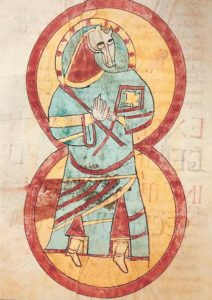Un processionnal des dominicaines du monastère des Emmurées de Saint-Mathieu de Rouen
Le couvent des frères prêcheurs de Rouen fut fondé par saint Louis, dans le manoir Saint-Mathieu, au faubourg Saint-Sever, hors le pont, que le roi avait acquis dès 1261 de l’archevêque Eudes Rigault, en échange du vivier de Martainville. Y succédèrent les religieuses dites Emmurées, et antérieurement Sœurs de Saint-Dominique. En juin 1266, le roi leur fit présent d’une épine de la sainte couronne et de magnifiques ornements. Après sa mort, on leur donna un des os de sa main, dans un reliquaire de cristal.
Farin nous apprend qu’on lisait autrefois, à l’entrée de l’église, la vieille épitaphe sur pierre, ci-après :
L’an mil deux cent soixante-neuf,
Ce monastère fut fait neuf
Que l’en dit les sœurs Emmurées,
Et lequel en temps ancien
Saint Louis, roi très chrétien.
De François fonda en ce lieu
Au titre de saint Mathieu
De son règne l’an troisième
Avec le quarantième.
(Histoire de Rouen, édition 1738)
En faite, la date de la fondation du premier monastère est inconnue. Il fut détruit en 962, et dépendait de l’abbaye de Marmoutier (Indre-et-Loire). Occupé par les jacobins de 1222 à 1247, puis par les dominicaines à partir de 1263. Chapelle construite fin 3e quart 13e siècle. Couvent ruiné lors du siège de Rouen par Henri V roi d’ Angleterre en 1418. Reconstruction de la chapelle, consacrée en 1479. Cloître 15e siècle. Couvent dévasté par les Calvinistes en 1562 et lors du siège de Rouen par Henri IV en 1591. Travaux de restauration au 17e siècle. Nef (et peut-être choeur) reconstruite en 1666. Supprimé à la Révolution. Bâtiments conventuels détruits vers 1855. Chapelle détruite par un incendie en 1876. Vestiges du cloître détruits vers 1935 © Inventaire général, 1986.
Sources: service régional de l’inventaire Haute-Normandie
Biblio: Paul Baudry, Le monastère des Emmurés, dans Revue de Rouen, 1848, p. 545-560. Sauvage, R.-N., Notes sur le monastère des Emmurées de Rouen, S.l.n.d. Voir cartulaire aux AD 76, H 68.
Arader Galleries de New York présente à la vente un processionnal ayant appartenu au monastère des dominicaines de Saint-Mathieu de Rouen. Le manuscrit fut par la suite en possession du bibliophile normand Jacques Ribard (sans-doute Jacques Paul Vincent Adrien Ribard (° 24/01/1738, + 11/11/1813), fils de Jean-Nicolas Ribard & d’Elisabeth Sangdelion.
Notice du catalogue:
PROCESSIONAL, for the use of Dominican nuns, in Latin and French, ILLUMINATED MANUSCRIPT ON VELLUM [France, c.1520 and 1674] 225 x 158 mm. 69 leaves: iv +18, 23 (ii a singleton), 310 (vii and viii a bifolium), 42, 5-64, 72, 88, 96, 10-144, pagination 1-132 followed here, pp.i-iv, pp.35-40, pp.65 and pp.83-134 are all part of the 1674 remodelling, when pp.133 and 134 were left blank, nine lines of music of square notation on a four-line stave of red between nine lines written in black ink in a gothic bookhand, justification: 193 x 108mm, rubrics in red, capitals touched yellow, original leaves with two-line initials of liquid gold on grounds of brick-red or blue and gold decoration within the rubrics, antiphons opening with either fine two-line illuminated initials with monochrome staves against grounds of liquid gold, usually with a flower-sprig as an infill, or with two-line black calligraphic initials with yellow wash, TWELVE LARGE HISTORIATED INITIALS with staves of liquid gold against grounds of red and blue, the biblical scenes in full colour and highlighted with liquid gold, TWO FULL-PAGE ILLUMINATED BORDERS, one of renaissance architectural forms, the other containing the standing figures of saints between flower-sprays against a liquid gold ground; the later leaves of the same format but with up to 28 lines on text-only pages, and restricted to two-line initials of red (borders rubbed, three historiated initials smudged, text erased and replaced, some text alterations made by pasting on updatings). Contemporary calf, panelled in blind with spine gilt in six compartments and with red morocco lettering-piece (some rubbing). CONTENT: Prefatory instructions ff.ii-iv; Table of contents ff.iv verso; chants for the processions on the following feasts: Purification of the Virgin, Palm Sunday, Holy Thursday, Good Friday, Easter Sunday, Ascension, Corpus Christi, Dedication of the Church, St Dominic, Assumption, St Louis, King of France, St Matthew, All Souls’ Day, St Adrian, St Roch pp.1-97; Offices for taking the veil, for the burial of the Dead and the Office of the Dead, Antiphon of St Barbara pp.97-132; chants in honour of the Virgin added in a slightly later hand pp. 133-134. The Processional has undergone extensive remodelling from its original form. This may have been to bring it into line both with post-Tridentine usage and the liturgical requirements of S. Mathieu at Rouen. Sections of text and music have been erased and replaced with detailed instructions and rubrics in French, often evoking a vivid picture of the ritual of religious life. ILLUMINATION: The historiated initials are the work of the illuminator known as the Master of Girard Acarie from his work in the splendid copy of the Roman de la Rose that Acarie presented to Francois I around 1525: Margareta Friesen, Der Rosenroman fur Francois I. New York Pierpont Morgan Library M.948, Graz 1993. The Master, along with the Master of the Ango Hours — with whom he sometimes collaborated — was part of the final phase of illuminated manuscript production in Rouen, where the trade in luxury manuscripts continued to flourish well into the 16th century, benefitting from the patronage of Cardinal d’Amboise, Louise of Savoy and other members of the court of Francois I. On a more modest scale, as befits its liturgical and monastic provenance, the present manuscript is, nonetheless, a characteristic demonstration of the Master of Girard Acarie’s decorative and suave style. The subjects of the historiated initials are as follows: p.1 Presentation in the Temple with full-page border; p.7 Entry into Jerusalem; p.18 Agony in the Garden; p.22 Christ washing Peter’s feet; p.41 Resurrection with full-page border; p.44 Transfiguration; p.49 Ruler offering bread and wine; p.55 Dedication of a Church; p.61 St Dominic; p.67 Assumption; p.73 St Louis; p.77 Apostle. Provenance: 1. The presence of three Dominican saints in the border of p.41 and the provision for the procession on the feast of St Dominic, p.61, suggest that the manuscript was originally made for the use of a Dominican convent. The style of illumination indicates that the manuscript was made in Rouen around 1425. 2. The title-page identifies the manuscript as ‘Pour le Chantre du Royal Monastere de S. Mathieu dit les Emmurees … Rouen‘ in the year 1674. The manuscript does contain the chants for the feasts of the Dedication of the Church and St Louis of France — founder of S. Mathieu — processions that the introduction says are specific to that convent, but it is unlikely that it was originally intended for the use of the precentress there. The manuscript was extensively modified in order to customise it, and other feasts specifically marked with a procession at the convent of S. Mathieu are part of the later additions, or, in the case of St Matthew, an adaptation of the feast for the Common of an Apostle. 3. M. Ribard, rue Morand [Rouen]: his label inside the upper cover. 4. Sir Thomas Phillipps (1792-1872): Ms 4393 (spine label and inscribed on flyleaf), bought from Royez; British Library, Loan 36/18.
Catalogue en ligne [Lien]
Leave a comment
PAGES ANNEXES
Auteur du blog : Jean-Luc DEUFFIC




